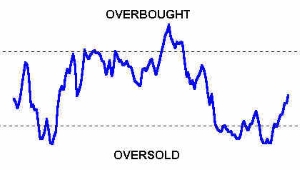What is Overbought & Oversold Forex Market?

Why are ranging markets so important, and why should one be interested in them? The answer is pretty simple, and comes from the fact that the Forex market is ranging most of the time. This may come as a surprise, as this market is best known as a market where prices of currency pairs travel a lot. In reality, most of the time prices are ranging, only that these ranges are forming on different timeframes.
| Broker | Bonus | More |
|---|
Defining an Overbought and Oversold Market
In order to define such an area, a trader should calibrate his/her expectations to suit the trading style involved. So if the trading style is based on an investing approach, this article is not for those traders. When investing, the period of time taken into account is fairly long, and a few hours, days, or even weeks of consolidation doesn’t change the trader’s perspective and analysis. As a result, overbought or oversold areas are not interesting for these traders. However, if the time perspective is shorter, then these areas can prove quite useful to swing and scalp traders. One thing should be mentioned, though, before we move forward: Markets can stay in an overbought or oversold area for longer than a trader can stay solvent. This means that there are only specific moments in time when it is advisable to trade these areas. Otherwise, the risk is of ending up chasing a move that will never come, and in the end, this will be reflected in the trading account.
Using Oscillators to Find Overbought and Oversold Areas in Ranging Markets
All oscillators offered show the same thing: overbought and oversold levels. No matter which one you choose, be it the Relative Strength Index (RSI), the Commodity Channel Index (CCI), DeMarker, or any other oscillator, the standard interpretation is the same: Traders should sell in overbought areas and buy in oversold areas. If this is correct, why are more than 90% of traders still losing money? The answer comes from traders now knowing when to use these overbought and oversold levels. Provided that a range market or a ranging environment is expected, the only way to find these areas is by using oscillators. Any oscillator from the ones listed above can show overbought and oversold levels. Based on what we discussed so far, it seems that the key is to know how to find a ranging market before selling in overbought, and buying in oversold, areas. Without this, it is virtually too risky to trade such levels.
When to Expect Ranging Conditions
By far the commonest way to look for a ranging market is to wait for the Asian session to start. Asian sessions spend most of the time in consolidation, as they follow the daily rollover, and the main financial centers in the world, London and New York, are closed. Having said that, it doesn’t mean that in Asia there are not enough traders to move the market; only that Forex trading is not done by retail traders, as they represent quite a small proportion of the overall foreign exchange markets. Big institutions, banks, investment houses, clearing houses, etc., are active during the London and New York sessions, and these are the times the market moves. What these institutions are doing is setting up a trading desk in Asia, but this is hardly a trading desk for new strategies to be deployed. It is a trading desk for being prepared to react to something that happens during the Asian session. The Bank of Japan (BOJ) and Reserve Bank of Australia (RBA) have their monetary policies in the Asian session, and the price moves aggressively surrounding those releases.
Lately, the People’s Bank of China (PBOC) has been acting more and more in correlation with other central banks, so Chinese news matters as well. Based on the above, the idea is to use an oscillator on the shorter timeframes (ideally the 5-minute chart), during the Asian session, for buying oversold and selling overbought levels. However, not all Asian sessions are recommended, as the ones when BOJ, RBA or PBOC are expected to hit the wires with some important news should be avoided.
Swing Trading with Overbought and Oversold Areas
Swing trading can also be used when trading overbought and oversold levels in ranging markets. For this, one should identify a longer period of time during which the price may range. The classical example here is the Non-Farm Payrolls (NFP) week. Such a week is usually a ranging one, in the sense that the NFP is always released on the first Friday of each trading month. As a result, in such a week one should expect ranges, so oscillators should be applied on currency charts. However, when compared with the previous case, one can use these oscillators on the hourly and even the 4-hour charts in order to identify fake moves into overbought and oversold areas. Using this example, if the market travels on a Tuesday of the NFP week, chances are that that break is a fake one, until the NFP prices get back into the initial range. This is when overbought and oversold levels are really useful, as they will help traders to profit from short- to medium-term swings.
Other educational materials
- Bollinger Bands – Profit from One of the Best Trend Indicators
- Trading with the Cloud – Use Ichimoku Cloud to Spot Reversals
- Trading Forex with the Kijun/Tenkan Cross
- What is a Currency Pair?
- Majors and Crosses – How to Trade Them?
- Leverage and Margin Requirements
Recommended further readings
- The econometrics of financial markets (Vol. 2, pp. 149-180) Campbell, J. Y., Lo, A. W. C., & MacKinlay, A. C. (1997). . Princeton, NJ: princeton University press.
- Forecasting volatility in financial markets: A review. Poon, S.H. and Granger, C.W., 2003. Journal of economic literature, 41(2), pp.478-539.


